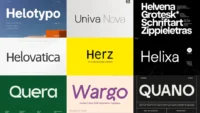In this article:
- Font Categories
- Does Size Matter?
- Don’t Go Crazy
- Match the Fonts to the Style
- Trust Your Gut
- Follow Experts
- Wrapping Up
Selecting the right font can make or break your company’s image. Whether you’re looking at a font for a company logo or for an academic project, it’s an important decision that shouldn’t be taken lightly.
In this article, I will talk about the different types of fonts and give you some tips for choosing the right one.
Font Categories
There are four major categories of fonts we will look at today. Sure, the total number of different letter fonts is so vast you could divide it into many groups. But for the purpose of this article, we will look at four major ones.
-
Serif fonts
These are the different fonts to write in that you likely will see in academic papers, newspapers and longer online publications. They can be determined by the little ‘feet’ or lines at the ends of every letter. These are traditional, well-recognizable fonts. They are said to make long, solid passages of text easier to read and comprehend. Here are the examples:
Times New Roman, Garamond, Georgia, Courier New
When you ask a service like DoMyEssay to write me an essay, they will inevitably use Times New Roman. This font is universally agreed on as the one for academic works.
-
Sans-serif fonts
This category includes fonts that are similar in popularity yet slightly different in appearance. Sans-serif fonts don’t have those small lines or ‘feet’ at the ends of letters. These fonts are considered even easier to read. They are mostly used for digital copies due to their simple but modern appearance. Examples:

Get 300+ Fonts for FREE
Enter your email to download our 100% free "Font Lover's Bundle". For commercial & personal use. No royalties. No fees. No attribution. 100% free to use anywhere.
Arial, Verdana, Lucida Sans, Calibri, and Tahoma.
-
Decorative fonts
As the name suggests, these fonts are way on the other side of the spectrum. Rather than for the body of text, these fonts are mostly used in headings or for bringing attention to a certain word or paragraph. Decorative fonts are often themed, like Gothic or Western ones. It’s important not to overuse a font like this since the text will look cluttered and hard to read if a decorative font is used throughout. Here is an example:
-
Script fonts
Script fonts mostly look handwritten. These cursive fonts look good on types of media where calligraphy and elegance are required. Think of formal invitations and logos for sophisticated places or events. These fonts can take the reader to a pre-industrial time when calligraphy was a valued skill, evoking feelings of nostalgia. One caveat with these fonts is that they tend to be less readable in small point sizes, but more on that later. E.g.:
Dawning of a new day, Sacramento, Sofia, Parisienne
Does Size Matter?
When it comes to fonts, size is of the essence. Script fonts contain many thin elements. Hence, they will not be easy to read in small point sizes. Decorative fonts, on the other hand, tend to be bulky and thick. They are meant to bring attention to a specific part of the text. Hence, they look better in bigger point sizes as well.
That’s why it’s important to test and review your font in the size that it will be used in, as some elements may disappear or become too attention-grabbing on the finished product.
Don’t Go Crazy
Using multiple fonts at a time is possible, and it’s a common technique used by modern designers. However, it still needs to be done in moderation. Most of the time, going crazy on the fonts does not benefit the final design. It can make it difficult to read or even look cheap. When using multiple fonts, the same tip applies — look at the final work in the size it will be used and see if it’s appropriate. Make sure that the fonts also translate the style that you want to convey, which takes us to the next point.
In different fonts alphabet is going to look different, but the best way to test the font is to use a phrase that includes all letters of the alphabet, rather than the alphabet itself. It looks more natural and provides you with a better idea of how the final project will look.
Match the Fonts to the Style
When it comes to logos or headlines, you don’t have much space to set the tone of the message. In a one- or three-word headline, you can’t waste space explaining your intent. Instead, the font has to do that for you. This is why it’s vital to pick a font that translates the tone of your message.
Think about luxury brands — they often use serif fonts in all caps. This gives them a classic yet modern and sleek look. On the other hand, grocery stores, for example, are often seen using sans-serif fonts. This makes them look more approachable. Decorative fonts look good on beauty studios, tattoo parlors or when something needs to be emphasized.
Trust Your Gut
Of course, when you have experience, any job gets easier. But even an inexperienced designer has an eye for good design — that’s why you’re in that line of duty. To convey the right tone, you have to trust your gut. If the font you chose feels wrong, it probably is. Marketing is mostly about emotion and gut feelings, so use that. Learn to trust yourself.
It’s important to take your time when choosing different letter fonts. Even the letter A in different fonts looks different, so don’t rush it. Review all your options and make a conscious decision.
Follow Experts
One of the main perks of social media is the free access to expert information on practically any topic. If you’re interested in design, marketing and typography, consider following topical resources. Blogs can give you an idea of what’s new and trending, and famous designers’ cases can enlighten you on the mistakes they’ve made in the past.
Typography books can not only make a beautiful addition to your book collection, but also give you inspiration. Flipping through one in the morning before work can give you ideas and help find the perfect font for a project.
Wrapping Up
According to different calculations, there are roughly 300,000 different fonts in existence. Choosing the right one among them all can take quite a lot of time. When making that choice, look at the alphabet in different fonts, numbers in different fonts and consider sticking to a certain category first. From serif to script, look at them in the size they will be used in. Try to convey the required tone and pick the appropriate size for your design.
Don’t forget to trust your gut feeling and follow experts for inspiration. Good luck!





